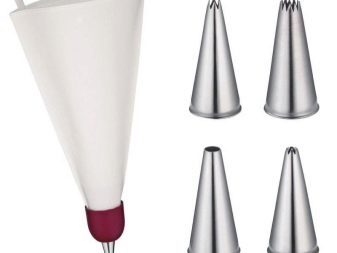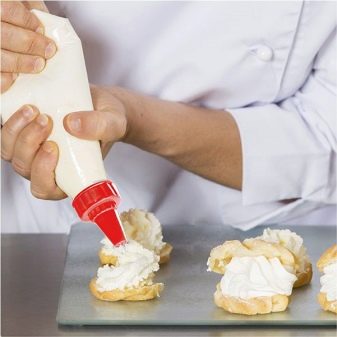Pastry bags: types, nuances of choice and application

Original cakes, cakes exclusively filled with cream and various desserts in the form of intricate figures have always attracted attention and aroused admiration for those with a sweet tooth.
To ensure that any home-made dessert does not lose to the pastry masterpiece of a professional pastry chef, you should have a pastry bag at hand.


Peculiarities
A pastry bag is an indispensable attribute and assistant not only for a professional pastry chef, but also for an ordinary housewife. Such a kitchen tool is similar in functionality to a pastry syringe - and this is not surprising, because it was created as an alternative to a cream syringe.
But the piping bag is much easier to use. Reusable bags are easy to wash and dry, while disposable bags are just thrown away. In addition, it is several times cheaper than a confectionery syringe.


Why do you need a bag?
A piping bag is a small pouch with a tapered end tapered downward. There is a hole at the end of the bag. Through it, when pressed, the cream comes out.
With this accessory, you can create real masterpieces of confectionery art. Decorating a cake with cream with intricate patterns or inscriptions is quick and easy with certain skills. Various patterns and shapes can be applied to any desserts using a pastry bag.
Even a novice confectioner and culinary specialist can cope with such a device with the correct mastering of the technique.


Types and materials
The variety of the selection of confectionery accessories is quite large. In general, there are only 3 options for such a tool:
- disposable products;
- reusable fabric products;
- reusable silicone products.
The name of the disposable instruments speaks for itself. This option is the cheapest, and after use it is not a pity to throw it away. The material for production is a special type of paper or food grade plastic. Paper is similar in properties to parchment or polyethylene, and bags made of these materials are more like a bag.

Some manufacturers produce attachments complete with bags. Unlike the bag itself, the nozzles are reusable. They are either plastic or metal. If the tool kit does not include attachments, the piping bag itself comes to replace them. Using the slices that are on it, you can create unpretentious, simple decorations.
Such tools are more suitable for decorating desserts with cream or light whipped cream. They are not intended for use with a dense filler consistency. When cooking, it will be problematic to adjust the amount of dough or cream. The cost of a disposable pastry bag ranges from 100 to 200 rubles.
Reusable fabric models are an expensive tool for professional chefs. It is these reusable products that culinary experts throughout Europe prefer to use. Such models are intended for baking pastries from liquid dough, for pancakes and airy desserts. The package includes attachments with different types of threads. This allows you to create curly ornaments, patterns and designs.
With these nozzles, you can adjust the density of the filler volume.


The attachments for reusable models can be attached to the outside of the product and from the inside. The first option is much better and easier. The only drawback of such tools is the need for a boiling and drying process. The seams on the bag may come apart if a poorly dried instrument is filled with mass.
To avoid such troubles, you should pay attention to the silicone reusable model. It is easier to wash such products from the remains of the filler. They also dry faster than fabrics. Silicone tools are as easy to use as fabric bags. The filler method is exactly the same.


Selection Tips
In order to choose the right confectionery tool, you first need to decide on the type of product.
Disposable bags are designed for narrow functionality. With the help of such products, comfortable work with a filler of a thin consistency is ensured. They are not suitable for thick dough or cream. It is worth remembering that the choice of a disposable product should be based on your own strengths. It is really very difficult to squeeze out and form a dense mass from a disposable model. The advantage of such products is their cheap cost for a large amount in a package.
Reusable pastry tools are aimed at preparing any desserts from batter and thick dough, equipped with various attachments for adjusting the volume of the filler and molding the decorations.


If the type of bag is chosen, it is worth paying attention to the details in order to purchase a quality product.
- Attention to the quality of the seams and their gluing. The gluing must be perfect - this contributes to long-term operation.
- Material and its strength.
- For the best option, it is worth considering a model with attachments that are attached to the outside of the product. Internal fixation of the attachments is inconvenient due to the presence of filler inside the bag. When pressed, the mass can flow out through the joint seams. With external fixing, the nozzle can fly off under the pressure of the filler.
- Wide products are very popular. For filling with cream or other fillers, you can use large tools rather than a teaspoon or dessert spoon. Wide bags are suitable for filling both liquid and thick mass.
- Choice of attachments. The attachments are made of plastic or metal.The first option has a low price, the second one will last much longer.
It is considered a big plus to have attachments complete with a bag. The use of confectionery tools becomes more convenient. In addition, you can experiment with the creation of jewelry, patterns, various designs and original figures from fragrant cream. The degree of complexity of a pastry chef's creation can be different. It all depends on imagination and originality.


How to assemble and use?
First, you need to figure out how the pastry tool works. The bag includes two parts. The first part is an adapter (connector), the second part is a ring or base. The base is inserted into the bag, after which the tip is attached to the part of the adapter, which partially sticks out of the product. After the ring is screwed in and secured, you can put on the nozzle.
But in order to use the piping bag correctly, you must assemble it following these instructions.
- First you need to remove the ring from the connector. Then the adapter should be pushed into the bag. You need to push the narrow end forward.
- Now you need to mark the end of the thread. On the reusable bag, you just need to mark the end of the thread with a pencil or pen. On the disposable bag, the mark will be 5 mm below the screw thread.
- Then you need to cut the pastry bag. To do this, it is necessary to push the adapter into the bag so that it is convenient to cut a hole according to the previously assigned mark. When pushing the adapter down through the hole, make sure one part is visible. Then you need to put on the carved attachment on the part that will stick out of the bag.
- At the final stage, you need to fix the ring back and insert the nozzle.



After the bag is assembled, you need to prepare it for use. To do this, its top must be assembled so that cuffs appear above the hand. Using a spatula, fill the product halfway and tamp. The main thing is not to overfill the bag with mass, otherwise the excess filler may come out from where it was not expected.
Next, you need to carefully pull the spatula out of the bag, as if wiping it on the bag. Then you need to close the product by twisting it. Before doing this, you must unfold the cuff. Before using it itself, be sure to release a small amount of the filler along with the air.
The piping bag is then ready for use.


There is nothing complicated about it. All you have to do is attach the nozzle, fill the instrument with cream or dough, push the filler closer to the tip and tamp well. You need to squeeze out the filler and form patterns or patterns in a clockwise direction.
In order to properly decorate desserts, pastries and cakes, it is also necessary to take into account the degree of pressure on the bag and its position against the work surface.
Before using this confectionery tool, you can first practice on any other surface. After that, it will not be so scary to decorate the main dessert.


By purchasing such a necessary tool, you can be sure of creating masterpieces of the culinary art. Before choosing a confectionery tool, you should decide what it will be used for. For those who cook sweets and desserts rarely, the disposable model is suitable. More professional pastry chefs prefer to use reusable tools with many interesting attachments that allow them to create masterpieces with beautiful ornaments, designs and shapes.
How to work with a pastry bag, see below.








